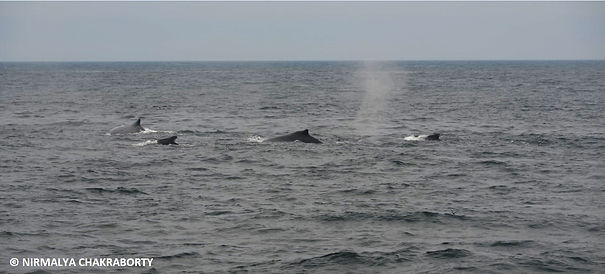STELLWAGEN BANK MARINE SANCTUARY
Oceanic ecosystems have always fascinated me. The Stellwagen Bank Sanctuary have provided me, a great opportunity to study these whales feeding and living a life in their summer home. I have been able to track and follow certain individuals (both males and females) and understand their behavior patterns along with sanctuary scientists.
The sanctuary support both benthic and pelagic species by providing cover and anchoring locations for invertebrates; they also provide feeding and nursery grounds for more than a dozen cetacean species including the endangered humpback, northern right, sei, and fin whales. The area supports foraging activity by diverse seabird species, dominated by loons, fulmars, shearwaters, storm petrels, cormorants, phalaropes, alcids, gulls, jaegers, and terns. Fish and invertebrate populations subject to seasonal and migration shifts include both demersal and pelagic species, such as bluefin tuna, herring, cod, flounders, lobster, and scallops. Leatherback and Kemp’s ridley sea turtles (endangered species) use the area for feeding.
North Atlantic Whales Migration Dynamics:
Winter: warm, low latitude tropical waters (breed and give birth)
Spring/Summer/Autumn: cooler, high latitude polar waters (feed)
Most humpback whales make mammoth journeys every year between their feeding and breeding sites. Because seasons are reversed either side of the equator, Northern and Southern Hemisphere populations of humpbacks probably never meet; those in the north travel towards their breeding grounds in tropical waters as those in the south are travelling towards the pole to feed, and vice versa.
Humpbacks are capable of travelling at 5 mph but, during such a long journey, they average only 1 mph, resting and socialising along the way. Not all members of a particular population will travel together however.







A Meeting with the WhalesHumpback Whales migrate to the sanctuary during summer to feed on the rich food sources of the Massachusetts Bay. During whale watching, the vessels keep their distance and do not crowd around the whales blocking their paths to avoid accidents.










WHALE SOUND RECORDING USING HYDROPHONE

HUMPBACK WHALES OF NEW YORK CITY ATLANTIC WATERS





HUMPBACK WHALES OF THE NORTH ATLANTIC OCEAN
The humpback social structure is loose-knit. Typically, individuals live alone or in small, transient groups that disband after a few hours. These whales are not excessively social in most cases. Groups may stay together a little longer in summer to forage and feed cooperatively. Longer-term relationships between pairs or small groups, lasting months or even years, have rarely been observed. Some females possibly retain bonds created via cooperative feeding for a lifetime. The humpback's range overlaps considerably with other whale and dolphin species—for instance, the Minke whale. However, humpbacks rarely interact socially with them.
Both male and female humpback whales vocalize, but only males produce the long, loud, complex "songs" for which the species is famous. Males produce a complex song lasting 10 to 20 minutes, which they repeat for hours at a time. Its purpose is not clear, though it may have a role in mating. Each song consists of several sounds in a low register, varying in amplitude and frequency, and typically lasting from 10 to 20 minutes. Humpbacks may sing continuously for more than 24 hours. Cetaceans have no vocal cords, so whales generate their songs by forcing air through their massive nasal cavities.
All North Atlantic humpbacks sing the same song, and those of the North Pacific sing a different song.
Most humpback whales make mammoth journeys every year between their feeding and breeding sites. Because seasons are reversed either side of the equator, Northern and Southern Hemisphere populations of humpbacks probably never meet; those in the north travel towards their breeding grounds in tropical waters as those in the south are travelling towards the pole to feed, and vice versa.
Whale Research Programs
The ability to recognize individual animals, whether through the use of tags, bands, or naturally-occurring marks, facilitates the study of their demography and behavior. High quality photographs are taken to confirm the identity of whales that have previously cataloged, and to add new individuals as they are encountered.
Matching a fluke photograph like this to a catalog of individuals takes good observational skills and patience.
Researchers focus on three things, in particular: pigmentation, distinctive marks and trailing edge shape. Taken together, these features of a humpback whale fluke are like a fingerprint, no two individuals are exactly alike.
OTHER OCEANIC FAUNA




Greater Shearwaters Greater Black Backed Gulls


Common Starfish Moon Jellyfish
